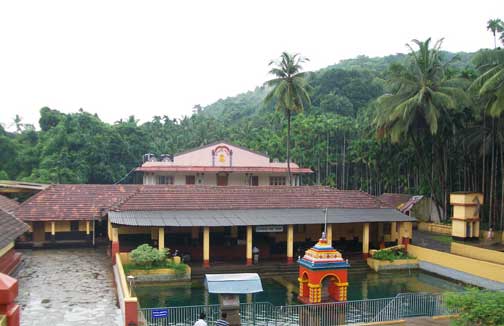Pay no mind to those who talk behind your back, it simply means that you are two steps ahead !!!
Wow ! Such a beautiful temple and the surroundings are also so peaceful and pristine. Yes, in Maharashtra it is celebrated as Naga Panchami. We too worship the snakes and offer them milk. As snakes are friends of farmers, there is a peculiar tradition observed in Maharashtra on this day, which is, only food that is steamed is eaten today, no cutting, shopping, or frying is allowed, no idea why. We make a sweet dish called 'dind' which is a kind of dumpling, a mixture of steamed chana dal is cooked with jaggery, to which nutmeg and cardamom is added., This mix is then filled into wheat puris and folded to form a squarish dumpling which is then steamed and eaten with ghee. My mum used to do all this, I don't!
"I am free of all prejudice. I hate everyone equally."
- W. C. Fields :)
In AP, the worshiping the snakes is prevalent after the 5th Day of Deepavali. It is known as "Nagula Chaviti."
Kalyani Nandurkar wrote:Wow ! Such a beautiful temple and the surroundings are also so peaceful and pristine. Yes, in Maharashtra it is celebrated as Naga Panchami. We too worship the snakes and offer them milk. As snakes are friends of farmers, there is a peculiar tradition observed in Maharashtra on this day, which is, only food that is steamed is eaten today, no cutting, shopping, or frying is allowed, no idea why. We make a sweet dish called 'dind' which is a kind of dumpling, a mixture of steamed chana dal is cooked with jaggery, to which nutmeg and cardamom is added., This mix is then filled into wheat puris and folded to form a squarish dumpling which is then steamed and eaten with ghee. My mum used to do all this, I don't!
@ rambabu
In AP, the worshiping the snakes is prevalent after the 5th Day of Deepavali. It is known as "Nagula Chaviti."
I guess worshiping snake god is prevalent among most Hindus ...many of our customs are similar along the Konkan coast...Kalyani, the sweet sounds lovely ! We make something similar the jaggery and coconut mixture filled into rice batter which is spread on turmeric leaves , which is then folded and steamed, very fragrant and tasty ( it is called manjalda ireta adye).Almost all hindu households make this and exchange it with friends from other community.In fact i just came back after visiting two of my christian friends who love the sweet ..
Pay no mind to those who talk behind your back, it simply means that you are two steps ahead !!!
The Nairs of Kerala and Tulu Bunts of Karnataka in South India also still carry out these ancient customs of snake worshiping.
Yes Tulu Bunts are from Mangalore and my mothers family belongs to that community...
Pay no mind to those who talk behind your back, it simply means that you are two steps ahead !!!
Worshiping snake. Nagas are an important part of Hindu mythology.. Nagas have different names too like Adiishesha, Vasuki etc.
Offering milk to snakes is not proper, as I have read that snakes do not consume it and in fact it may be poisonous to them. However traditions are to be followed but if scientifically it is true than reform can be done. Nagas or serpents have a special place in Hinduism and in past I have seen many bow with folded hands to the snake of a snake charmer. However in China I have seen snakes kept alive in bottles at the entrance of hotels and customers can select one for it being served to them inside. Different cultures different customs.
Traditions in Hiduism on snake worshiping we are discussing. When it comes to scientific evidence,the fact is Snakes are reptiles, not mammals to drink milk. Milk cannot be digested by reptiles and they eventually die!
And would you believe that all Nagas (people of Nagaland) irrespective of their religion eat Nagas (snakes). A Mongolian tradition like people in many east Asian countries (including China) prefer to eat snakes in many ways.
In our country snake is associated with Lord Shiva so people worship snakes too.
I for some snakes are sacred, for some snakes are food, that too delicious food. Live snakes are more in demand as eatables.
Page 1 of 3

 Kudupu where I went and offered milk, coconut, flowers etc...I am not religious and often wonder whether the same milk and coconut would be better off given to a poor family rather than be poured over a snake hill...But it is a tradition and in the words of my ancestors we need to practice it to keep it alive ..please share your views...I have uploaded the picture of the temple which is very old, beautiful surrounded by mountains and paddy fields..
Kudupu where I went and offered milk, coconut, flowers etc...I am not religious and often wonder whether the same milk and coconut would be better off given to a poor family rather than be poured over a snake hill...But it is a tradition and in the words of my ancestors we need to practice it to keep it alive ..please share your views...I have uploaded the picture of the temple which is very old, beautiful surrounded by mountains and paddy fields..

